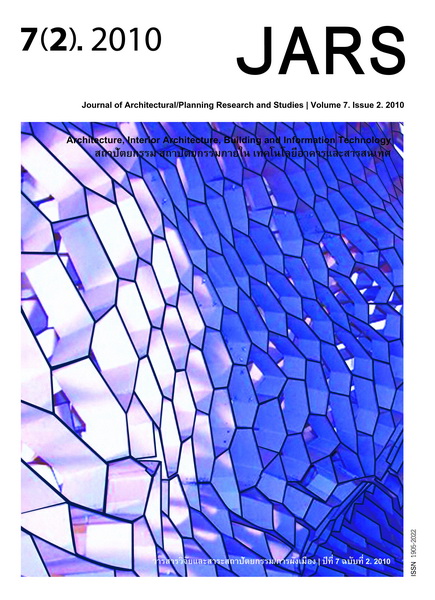CO2 Uptake Performance of Climbing Plant Wall
Main Article Content
Abstract
Carbon dioxide is the major greenhouse gas that increase rapidly during th past two centuries. Growing trees to absorb Carbon dioxide is a fundamental effort to mitigate global warming, but was always limited in high density city. Climbing plants on wall can also be a solution to increase green area and absorb Carbon dioxide as much as growing trees or shrubs on ground, if receive enough sunlight, by occupying much less
ground area. This research aims to study CO2 uptake performance of different climbing plants which are local for Thailand, low maintenance, good leaf coverage and fast growing. Two experiments were carried out. The first one is to find CO2 uptake from Photosynthesis rate measured on leaves with different ages, comparing three climbing plants. The second experiment was carried out on 1x1 m panel covered with climbing plants on both side, to find real amount of CO2 uptake from air chamber. It was founded that three selected climbing plants perform differently. Thunbergia grandiflora has the highest rate of CO2 uptake, while Antigonon leptopus and Coccinia grandis rank in second and third in both experiments. The maximum amount of CO2 uptake of 1x1 m Thunbergia grandiflora wall is 20 ppm, Antigonon leptopus 15 ppm, Coccinia grandis 5 ppm
from 1 M3 air per 10 seconds.
Downloads
Article Details

This work is licensed under a Creative Commons Attribution-NonCommercial-NoDerivatives 4.0 International License.
All material is licensed under the terms of the Creative Commons Attribution 4.0 International (CC-BY-NC-ND 4.0) License, unless otherwise stated. As such, authors are free to share, copy, and redistribute the material in any medium or format. The authors must give appropriate credit, provide a link to the license, and indicate if changes were made. The authors may do so in any reasonable manner, but not in any way that suggests the licensor endorses you or your use. The authors may not use the material for commercial purposes. If the authors remix, transform, or build upon the material, they may not distribute the modified material, unless permission is obtained from JARS. Final, accepted versions of the paper may be posted on third party repositories, provided appropriate acknowledgement to the original source is clearly noted.
References
Brown, R., & Gillespie, T. J. (1995). Microclimatc landscape design: Creating thermal comfort and energy efficiency. New York: John Wiley & Sons.
Blanc, P. (2008). The vertical garden, from nature to city. New York: W.W. Norton & Company.
Kasemsap, P. (1999). ต้นไม้กับมลพิษทางอากาศ [Trees and air pollution]. In National Planting Day, 91-106. Department of Public Park, Bangkok Metropolitant Administrator, Bangkok, Thailand: Boonsin Publishing.
Kasemsap, P. (2008). การสังเคราะห์ด้วยแสง [Photosynthesis]. In Biology 2. The Promotion of Academic Olympiad and Development of Sceince Education Foundation, Bangkok, Thailand: Dan Sutha Publishing.
Keeling, D. (2010). Atmospheric CO2 Mauna Lao Observatory. Retrieved November, 2010, from http://co2now.org/
Kromdijk, J., Schepers, H. E., Albanito, F., Fitton, N., Carroll, F., Jones, M. B., Finnan, J., Lanigan, G. J., & Griffiths, H. (2008). Bundle sheath leakiness and light limitation during C4 leaf and canopy CO2 uptake. Plant Physiology, 148, 2144-2155. Retrieved November, 2010, from http://www.plantphysiol.org
Osborne, C., LaRoche, J., Garcia, R. L., Kimball, B. A., Wall, G. W., Pinter, P. J., Jr., La Morte, R. L., Hendrey, G. R., & Long, S. P. (1998). Does leaf position within a canopy affect acclimation of photosynthesis to elevated CO 2?. Plant Physiology, 117(1), 1037-1045. Retrieved November, 2010, from http://www.plantphysiol.org
Pangsee, I., Pitchakum, N., & Kasemsap, P. (2009). ความสามารถของสวนหย่อมในการดูดซับก๊าซคาร์บอนไดออกไซด์ [Ability of decorative gardens on Carbon Dioxide absorption]. Agricultural Sceince Journal, 40(2), 209-218.
Salisbury, F. B., & Ross, C. W. (1985). Plant Physiology (3rd ed.). Belmont, California: Wadsworth Publishing.
Wolverton, B. C., Johnson, A., & Bounds, K. (1989). Interior landscape plants for indoor air pollution abatement. NASA/ALCA Final Report. Plants for Clean Air Council. Davidsonville: Maryland.
Yeang, K., & Hamzah, T. R. (2000). The Bioclimatic Skyscraper, Revised Edition. London: Ellipsis Limited.
US EPA (2010). Emission Climate Change. Retrieved November, 2010, from http://www.epa.gov/climatechange/fq/emissions.html#q7


